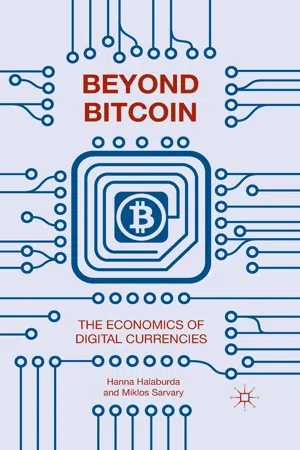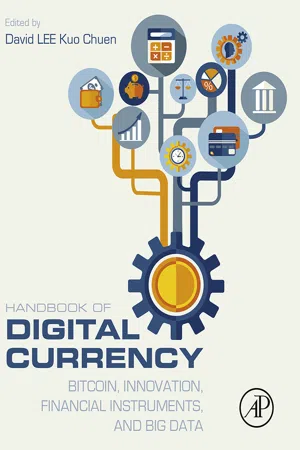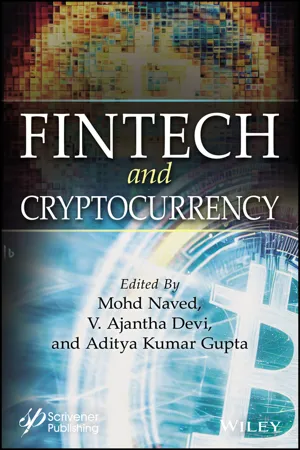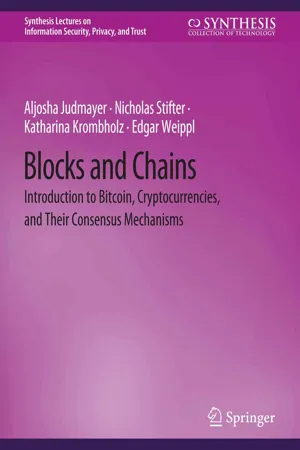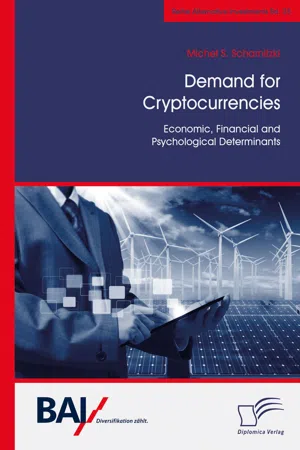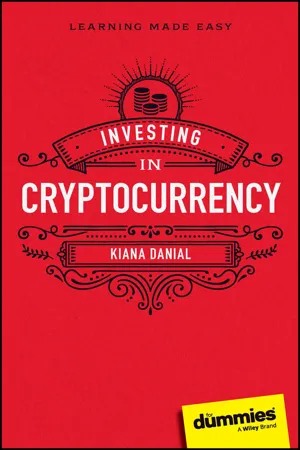Economics
Cryptocurrencies
Cryptocurrencies are digital or virtual currencies that use cryptography for secure financial transactions. They operate on decentralized networks based on blockchain technology, which ensures transparency and security. Bitcoin, Ethereum, and Litecoin are some well-known examples of cryptocurrencies. Their value is determined by supply and demand in the market, and they have gained attention as an alternative form of investment and payment method.
Written by Perlego with AI-assistance
Related key terms
1 of 5
10 Key excerpts on "Cryptocurrencies"
- eBook - PDF
- John E. Marthinsen(Author)
- 2020(Publication Date)
- De Gruyter(Publisher)
Chapter 11 The Economics of Cryptocurrencies The creation and evolution of Cryptocurrencies , such as bitcoin, Ether, Dash, Ripple, Monero, NEO, EOS, Litecoin, Zcash, and Cardano, have captured the at-tention and imagination of many. Today, hundreds of Cryptocurrencies are alive and functioning, with more to come. 1 What are Cryptocurrencies? Who or what creates them, and where can I go to buy one? Are they legal to use and own? Governments, central banks, and international agencies around the world have been paying closer attention to the growth and development of Cryptocurrencies, due to the potential threat they pose to nations ’ financial stability, their seemingly close connection to criminal activities, and the difficulties of tracking crypto payments and re-ceipts. The prospects for what Cryptocurrencies can do are as potentially excit-ing and rewarding as they are dangerous and threatening — especially in the area of personal privacy and users ’ vulnerability to financial losses. This chapter explains Cryptocurrencies and how they differ from fiat money. It goes on to describe how and where to buy and sell them, their relationship to blockchain, the platform on which they are built, and how the forces of supply and demand determine cryptocurrency exchange rates. Do these currencies have the potential to alter the effectiveness of monetary and fiscal policies? Are crypto-currencies money? The Basics Legal Tender, Fiat, Digital, and Cryptocurrencies A convenient and helpful entry point into the cryptocurrency discussion is differentiating among legal tender, fiat currencies, and digital currencies. - eBook - PDF
Beyond Bitcoin
The Economics of Digital Currencies
- Hanna Halaburda, Miklos Sarvary(Authors)
- 2016(Publication Date)
- Palgrave Macmillan(Publisher)
4 C h a p t e r 4 C ryptocurrencies So far in this book, we saw digital currencies issued by digital platforms. These innovations are a good object to start with when analyzing the economics of digital cur - rencies. However, when people hear “digital currency,” their first thoughts will likely be “Cryptocurrencies” and “Bitcoin.” This is not surprising: for the past few years, these terms have appeared frequently in popular media, in technical discussions, and even in policy debates and legis- lation. We now move on to this second type of digital cur - rencies, specify the main differences with platform-based digital currencies, and discuss what implications such dif- ferences have for the economics of cr yptocurrencies and for their potential widespread adoption. Before we do this, however , we would be remiss not to discuss the trigger (or, if you prefer, the culprit) of the ongoing media commotion: the Bitcoin. As we will see, Bitcoin is a decentralized digital currency invented in 2008 by somebody hiding behind the pseudonym of Satoshi Nakamoto. Nakamoto proposed Bitcoin to address an economic problem inherent in electronic commerce: the frictions and the high transaction costs of trading over the B e y o n d B i t c o i n 98 Internet, particularly relevant for small-value transactions. Indeed, while the key innovation in Nakamoto’s paper is cr yptography and computer science, those who read it often comment on how much space it devotes to econom- ics and a theory of money of the sort we discussed in the first chapters of this book. In its early years, Bitcoin has been known to a rela- tively narrow community of cryptography enthusiasts. The first time the currency made it into the mainstream media was probably in June 2011, during the WikiLeaks affair. WikiLeaks is a website that publishes information, especially news leaks and secret information from classi- fied sources. - eBook - ePub
Handbook of Digital Currency
Bitcoin, Innovation, Financial Instruments, and Big Data
- David Lee Kuo Chuen, David LEE Kuo Chuen(Authors)
- 2015(Publication Date)
- Academic Press(Publisher)
It is very easy to create a cryptocurrency as an alternative currency for free today. However, most of these new creations will cease circulation within a relatively short time. With many alternative currencies in competition, only a few will be globally adopted, reach a sufficient scale, or find a suitable market. Unless the idea of national digital currencies takes off, it is likely that many of these alternative currencies will cease circulation because of superseding advancements in technology, tighter regulation, and insufficient demand.1.3 Cryptocurrency
1.3.1 The nature of cryptocurrency
Cryptocurrency in its purest form is a peer-to-peer version of electronic cash. It allows online payments to be sent directly from one party to another without going through a financial institution. The network time-stamps transactions using cryptographic proof of work. The proof-of-work Bitcoin protocol is basically a contest for decoding and an incentive to reward those who participate. For Bitcoin, first participant to crack the code will be rewarded with the newly created coins. This contest will form a record of the transactions that cannot be changed without redoing the proof of work.Cryptocurrency is a subset of digital currency. Examples of the many digital currencies are air miles issued by airlines, game tokens for computer games and online casinos, Brixton Pound to be spent only in the Brixton local community in the Greater London area, and many other forms that can be exchanged for virtual and physical objects in a closed system and, in the case of an open system, exchanged for fiat currency.1.3.2 The beginning: eCash
Commercially, it all began with DigiCash, Inc.'s eCash system in 1990, based on two papers by its founder (Chaum, 1983 - eBook - PDF
- Qing Zhou(Author)
- 2019(Publication Date)
- Society Publishing(Publisher)
• Cryptocurrency is the digital currency which is known to be extremely safe and secure as it uses blockchain technology and cryptography to create a safe and confidential environment. There is scope to perform transfers, exchanges, and several other operations only when the accord reaches the different nodes that are present in the network. • Cryptocurrencies have enormous potential for development, and they may take over several currencies that are present in the market. • There were a number of investors who made several investments in the second half of 2017 which led to the rise and increase in the value of cryptocurrency. For instance, the value of Bitcoin raised from $371 in January 2016 to more than $13,000 by the end of December 2017. In addition, the market capitalization of BTC increased from $0.04 billion in first quarter (Q1) 2012 to over $230 billion in first quarter (Q4) in 2017. • Though there is general drop in the value of Bitcoin by the January 2019 when compared to the July 2018, still the value of the Bitcoin is known to be around $3,300–$3,700 per Bitcoin. Economy and Alternative Currencies 51 This indicates a significant growth in the value of Bitcoin ever since 2017. The rate of growth is known to be nearly five factors ever since January 2017. • The Cryptocurrencies are generally open source which is a major advantage as being open source would make their source code be available to everyone across the globe. • The Bitcoin and Cryptocurrencies have a scope and possibility to spread across the globe. • There is a general trend in the increased use of Cryptocurrencies across several businesses, and there is an increase in the number of businesses that are showing a “Cryptocurrencies accepted here” sign every month by month. 2.5.3. A Wall of Restrictions There are several regulators of cryptocurrency who are present at a global level, and they are known to have a skeptical and vague idea and comprehension regarding cryptocurrency. - eBook - PDF
- Mohd Naved, V. Ajantha Devi, Aditya Kumar Gupta(Authors)
- 2023(Publication Date)
- Wiley-Scrivener(Publisher)
It is important to generate research findings useful for policy-makers, businesses, and society and can be disseminated and replicated by scholars outside the financial community. Cryptocurrencies: an asset on a block- chain that can be exchanged or transferred between network participants and hence used as a means of payment but offers no other benefits. Within 96 Fintech and Cryptocurrency Cryptocurrencies, it is then possible to distinguish those whose quantity is fixed and price market-determined (floating Cryptocurrencies) and those where a supporting arrangement, software or institutional, alters the sup- ply to maintain a fixed price against other assets (stable coins, for example, Tether or the planned Facebook Libra). 5.4 Findings Cryptocurrencies are part of a larger class of financial assets known as “crypto-assets,” which have similar peer-to-peer digital value transfers without the use of third-party organizations for transaction certification. What makes Cryptocurrencies different from other crypto-assets? This depends on their intended use, i.e., whether they are given just for transfer or to serve other purposes. One can continue the differences highlighted in current governmental reports within the general category of crypto-assets, differentiating two additional sub-categories of crypto-assets on top of cryptocurrency (Pavlidis, 2020). • Cryptocurrencies are a type of asset on a blockchain that can be transferred or moved between network members and therefore used as a form of payment—but with no additional features. • Crypto securities are a type of blockchain asset that also has the potential for future payments, such as a portion of earnings. • Crypto utility assets are blockchain assets that may be exchanged for or used to access pre-defined services or operations. - eBook - PDF
Blocks and Chains
Introduction to Bitcoin, Cryptocurrencies, and Their Consensus Mechanisms
- Aljosha Judmayer, Nicholas Stifter, Katharina Krombholz, Edgar Weippl(Authors)
- 2022(Publication Date)
- Springer(Publisher)
15 C H A P T E R 3 History of Cryptographic Currencies The history of cryptographic currencies rests on two foundations. The first is the history of dis- tributed systems research in general, and the second is the history of electronic cash systems. In the early days, these two areas of research had very few connections with each other, despite the use of cryptographic primitives. Both fields are related to research and advances in cryptog- raphy, and particularly research in the area of electronic cash was driven by the inventions in the area of asymmetric cryptography, e.g., blind signature schemes. In retrospect, Bitcoin pro- vided the missing link between those fields of research to create a decentralized cryptographic currency. Bitcoin cherry-picked the right pieces from each of these areas and combined them. One byproduct of the rise of Bitcoin is an increased interest in distributed systems research as well as in electronic payment systems and currencies. In this chapter, we take a brief look at the history of cryptographic currencies before Bit- coin and the beginnings of this field of research. Therefore we focus on the technical innovations and the context of existing research at that time rather than individual persons or legal defini- tions. The purpose of this chapter is to provide a basic understanding of historical events that impacted cryptocurrency research and the community around it. Legally cryptographic currencies of all types fall under the definition of a virtual currency. The term virtual currency was defined by the European Central Bank in 2014 as “a digital rep- resentation of value that is neither issued by a central bank or a public authority, nor necessarily attached to a fiat currency, but is accepted by natural or legal persons as a means of payment and can be transferred, stored or traded electronically” [9]. In Chapter 6, we describe the history from a distributed systems perspective. - Michel S. Scharnitzki(Author)
- 2020(Publication Date)
- Diplomica Verlag(Publisher)
However, these applications of the distributed ledger technology will not be further discussed in this paper. 18 3.3 Cryptocurrencies: Financial Asset or Money? In order to get a better understanding of the driving factors for the demand of Cryptocurrencies it is important to understand the expectations of buying Cryptocurrencies. In context of this project a central aspect is whether participants see Cryptocurrencies as a medium for daily transactions or as an investment. For that purpose, question ten asks the participants what they personally see as advantages of Cryptocurrencies. Three possible multiple choice answers were provided. The first answer was: a short-term investment, which 34 (48.57%) answered with yes. 22 (31.43%) participants thought of Cryptocurrencies as a long-term investment. Only 24 (34.29%) stated that they saw Cryptocurrencies as a new method of payment. This is especially interesting because Nakamoto’s (2008) initial goal was to invent a new payment system. In addition to the given answers, the participants had the possibility to express their own thoughts. The given answers included statements like: “take power from the government and banks”, “currency without centralized control”, “speculation” and “insights into Blockchain technology”. 11 (15.71%) participants saw themselves not gaining anything from Cryptocurrencies. Krugman (1984) defines money as an asset that fulfils three purposes. (1) It can be used as a unit of account: money provides the terms in which prices are quoted and debts are recorded. (2) It operates as a medium of exchange: money is the medium to buy goods and services. (3) It functions as store of value: money is a way to transfer purchasing power from the present to the future. All three requirements are fulfilled by Cryptocurrencies. In an expanding number of places, Cryptocurrencies are accepted as payment methods.- eBook - PDF
- Kiana Danial(Author)
- 2023(Publication Date)
- For Dummies(Publisher)
» In most cases, a bunch of intermediaries, such as banks and brokers, take a cut in the process, making transactions expensive and slow. 8 PART 1 Getting Started with Cryptocurrencies » Financial inequality is growing around the globe. » Your assets could be confiscated. » Around 3 billion unbanked or underbanked people can’t access financial services. That’s a big chunk of the planet’s population! Cryptocurrencies aim to solve some of these problems, if not more. This chapter introduces you to crypto fundamentals. Beginning with the Basics of Cryptocurrencies You know how your everyday, government-based currency is reserved in banks? And that you need an ATM or a connection to a bank to get more of it or transfer it to other people? Well, with Cryptocurrencies, you may be able to get rid of banks and other centralized intermediaries altogether. That’s because cryptocur- rencies rely on a technology called blockchain, which is decentral- ized (meaning no single entity is in charge of it). Instead, every computer in the network confirms the transactions. Turn to Chapter 4 to find out more about the blockchain technology that enables cool things like Cryptocurrencies. In the following sections, I go over the basics of Cryptocurrencies: their background, benefits, and more. The definition of money Before getting into the nitty-gritty of Cryptocurrencies, you need to understand the definition of money itself. The philoso- phy behind money is a bit like the whole “Which came first: the chicken or the egg?” thing. In order for money to be valuable, it must have a number of characteristics, such as the following: » Enough people must have it. » Merchants must accept it as a form of payment. » Society must trust that it’s valuable and that it will remain valuable in the future. CHAPTER 1 Introducing the World of Cryptocurrencies 9 Of course, in the old days, when you traded your chicken for shoes, the values of the exchanged materials were inherent to their nature. - eBook - PDF
- Kiana Danial, Tiana Laurence, Peter Kent, Tyler Bain, Michael G. Solomon(Authors)
- 2021(Publication Date)
- For Dummies(Publisher)
That’s approximately half the population on the planet! Cryptocurrencies aim to solve some of these problems, if not more. This chapter introduces you to crypto fundamentals. Chapter 1 IN THIS CHAPTER » Looking at the what, why, and how of the advent of Cryptocurrencies » Getting an overview of your first steps before starting your crypto journey 8 BOOK 1 Cryptocurrency Basics Beginning with the Basics of Cryptocurrencies You know how your everyday, government-based currency is reserved in banks? And that you need an ATM or a connection to a bank to get more of it or transfer it to other people? Well, with Cryptocurrencies, you may be able to get rid of banks and other centralized middlemen altogether. That’s because Cryptocurrencies rely on a technology called blockchain, which is decentralized (meaning no single entity is in charge of it). Instead, every computer in the network confirms the transac-tions. Flip to Book 2 to find out more about the blockchain technology that enables cool things like Cryptocurrencies. The following sections cover the basics of Cryptocurrencies: their background, benefits, and more. The definition of money Before getting into the nitty-gritty of Cryptocurrencies, you need to understand the definition of money itself. The philosophy behind money is a bit like the whole “which came first: the chicken or the egg?” thing. In order for money to be valu-able, it must have a number of characteristics, such as the following: » Enough people must have it. » Merchants must accept it as a form of payment. » Society must trust that it’s valuable and that it will remain valuable in the future. Of course, in the old days, when you traded your chicken for shoes, the values of the exchanged materials were inherent to their nature. But when coins, cash, and credit cards came into play, the definition of money and, more importantly, the trust model of money changed. Another key change in money has been its ease of transaction. - eBook - ePub
Understanding Bitcoin
Cryptography, Engineering and Economics
- Pedro Franco(Author)
- 2014(Publication Date)
- Wiley(Publisher)
substitutes. Critics argue that many Cryptocurrencies will be created, competing with each other in a race to the bottom that will end in hyperinflation and collapse. This view assumes that all Cryptocurrencies achieve the same level of acceptance. Proponents of Bitcoin reply that Cryptocurrencies are subject to network effects, due to infrastructure investment, marketing, mind-share and liquidity. Bitcoin currently holds the lead due to its first moving advantage, but if other Cryptocurrencies were to replace it in the future, the network effect would favor the leading cryptocurrency, as the market tends to gather around this leading cryptocurrency due to the network effect. The issue of alternative Cryptocurrencies is discussed in more detail in section 11.8.Critics argue that Bitcoin cannot be used as a store of value because of its volatility. Contrary to fiat currencies, there is no authority, such as a central bank, to ensure the stability of its value. Thus the price of bitcoin could be subject to self-fulfilling dynamics, where an incident could feed back on itself, becoming a full-blown confidence crisis.There is no control over the money supply. The money supply can be changed through a majority process, first through the open source project, and then through miners and users agreeing to the change.Holding bitcoins is not a good protection against inflation because if the price of bitcoin relative to fiat rises as a consequence of inflation, the gains would be taxable. Bitcoin proponents argue that this is true for most assets, and in any case holding bitcoin would constitute a partial hedge against an inflationary increase in the money supply of fiat currencies.Cryptocurrencies do not have legal tender status. In contrast, fiat currencies usually have legal tender status, meaning all debts can be settled with them in their respective countries.Governments could ban the use
Index pages curate the most relevant extracts from our library of academic textbooks. They’ve been created using an in-house natural language model (NLM), each adding context and meaning to key research topics.

